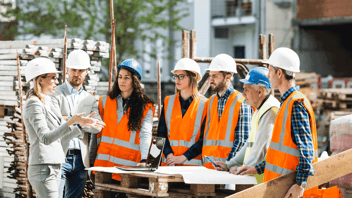While worker safety is essential in any industry, construction poses one of the highest risks to workers. Workplace injuries are to be expected, especially in more physically tasking jobs.
However, workers in construction experience the highest number of workplace deaths. This makes construction one of the most dangerous industries in the world.
The need for new construction projects will only increase over time, and this demand will put workers at further risk. So, the question remains, how can the construction industry safely move forward and prevent death and injury as it continues to expand?
The answer lies in new technology that will keep workplaces safe. With modern tech, construction workers can significantly reduce the risk of injury and find better ways to work safely and efficiently. Here we are going to dive into five ways innovative technology is solving construction industry risks.
How New Technologies are Creating a Vibrant Future for the Construction Industry
A range of new construction safety technology could help deal with workplace safety issues. Some of this innovative technology is still in early development, but there are many available tech solutions that can be used now to improve work conditions and safety.
We’ll review some of the top new technologies that will solve construction risks and bring the construction industry into a new age of innovation.
1. Virtual Training Reduces Workplace Injuries
Providing in-depth job training is the best way to prevent workplace accidents and negligence claims for personal injury. Safety training should be a top priority for every workplace. And, teaching workers how they can safely do their job and stay aware of potential dangers can help mitigate many issues.
Still, on-site job training can be dangerous for those in the construction industry. Workers need to know how to handle their tools and complete various tasks. But without the proper experience, people can end up hurting themselves as they train. This is where technology can be beneficial for the construction industry.
Virtual Reality (VR), and Augmented Reality, let workers safely practice crucial skills they need to use in the workplace. Many industries are already using this cutting-edge tech to promote worker safety, which includes both military and medical jobs.
Training in a virtual setting prevents any potential training injuries and will help workers learn the skills they need in a realistic augmented reality. In addition, through virtual tech, safety training is more easily tracked and managed. So, those in charge of exercise can ensure everything is completed on track and thoroughly.
2. Wearable Technology Has Improved Worker Safety
Another way construction sites are keeping workers safe is by implementing wearable technology. Hard hats, gloves, boots, and protective clothes are a must. But new wearables are being included as protective equipment.
Smartwatches and smart glasses are popular options that track vitals, skin temperature, movement, and location. These wearables can alert managers and other personnel if workers have fallen or need medical attention. GPS tracking also lets workers know if they are in dangerous areas at a construction site.
More advanced technology is also being developed. Smart vests can cushion falls and act as an airbag in dangerous situations. Some techs can even alert workers when toxic gasses and substances are nearby, while other smart-powered suits will help workers reduce injury by helping lift heavy objects.
3. Detection Technology and Onsite Sensors Keep Workers Safe
Wearables aren’t the only trackable technology found at construction sites. With so many potential hazards, onsite sensors and cameras can help track and better orient workplaces toward safe job outcomes.
Sensors are being placed in a multitude of hazardous locations. These sensors can monitor work conditions and alert workers about safety risks. This includes hazardous materials, air quality, temperature, and other salient environmental conditions.
The data is tracked and sent to the OSHA, the Occupational Safety and Health Organization. With these preventative measures, workers can feel safer at construction sites.
4. Drones and Robots Can Take on More Dangerous Tasks
Humans are an absolute necessity in construction sites. However, some hazardous tasks are better left to robots. While most robots still need supervision, this technology is beneficial, especially when preventing workplace injuries.
Robots can be used for heavy lifting and remotely controlled environments humans can’t enter. While robots can become broken, this new innovative technology minimizes the risk to human life.
Drones are also starting to make their way into construction and construction inspection. These state-of-the-art devices can fly high and scout out hard-to-reach spaces. With the click of a button, construction workers can scan the quality of work and even detect dangerous changes to work conditions, such as gas leaks and structural issues.
This is vital as human workers can’t be everyone at once and don’t always know when the construction site has become hazardous. More importantly, inspectors can quickly analyze construction projects from a safe location to ensure efficacy.
People are starting to use drones to inspect bridges and towing buildings that are more difficult to scale, as well.
5. Completely Digitizing The Safety Process
In the past, safety processes were all done through paperwork. Forms and other vital documents were filled out by hand to ensure that proper safety practices were being followed. But it wasn’t always easy to track and keep people accountable for safety this way.
Our more digitized age has transformed the way construction sites handle the safety process. These days, many companies in the construction industry have gone entirely digital.
For instance, work permits have been digitized and are more rigorously checked with a digital permit-to-work system. Furthermore, with digital databases and other systems, each step of the construction process can be tracked and monitored through digital paperwork that is easy to access.
In short, there are more safety measures put in place. And it’s harder to forge documents and bypass specific safety protocols with a digital system.
Why Innovation is Important for Construction Industries
Safety is crucial because technological innovation is needed in the construction industry. Still, other essential reasons companies need to adapt to modern tech exist. In this final section, we’ll go over how this technology can help with construction projects and the industry in general.
Increase Productivity and Keep Construction Projects on Track
Construction is a vital industry that drives the economy and keeps our communities thriving. Through construction, homes, commercial buildings, government buildings, and other infrastructure are built safely and swiftly.
However, as we have discussed, the demand for construction projects and jobs are forecasted to grow in the coming years. As our population rises and the need for housing and buildings increases, construction companies will need to find new ways to boost productivity and keep their projects on track.
This is why new innovative technology will be important in the future. If those in the construction industry can’t keep up with demands, this could cause significant delays and even safety problems for construction workers and the public.
We all rely on the construction industry to maintain infrastructure and grow our cities and towns. So, the new tech must be used to enhance productivity. This way, construction can be planned correctly and kept on track.
Digitalizing Construction Projects will Allow Industry Professionals to Focus on What’s Important.
While humans must take charge of construction projects, we don’t have to be involved in every aspect of management. In fact, with AI and other intelligent machine learning technology, those in construction can focus on the most critical parts of their projects. Smaller tasks can be automated and completed by artificial intelligence.
With this new technology, workers can attend to what matters as AI takes care of tasks requiring less human attention. Over time this will decrease the time it takes to complete projects and even helps prioritize safety, as workers won’t have to worry themselves thin over many different tasks.
For instance, locating tools, people, building materials, and even the proper equipment can be done by AI. Intelligent software can analyze on-site data and help create more reasonable work practices. We’ll discuss the upsides of this in the next section.
New Innovative Technology Will Help Reduce Costs and Streamline Construction Projects
One of the big benefits of technology is its ability to streamline our lives. It’s easier than ever to shop, plan our days, send important documents, as well as, do a range of other tasks. This can also be applied to construction.
AI, in particular, will help reduce costs and make work sites more efficient and cost-effective. With their ability to analyze data at lightning speeds, this smart tech not only tracks workers and keeps them safe, but it also has the ability to make workplaces more advanced.
With the power of intelligent software, construction companies can figure out how to best spend their time during the workday. Potential costly delays can also be worked around as progress is easily tracked by cameras and other wearable technology. In addition, AI can alert workers when building supplies are low.
Best of all AI tells workers when there are structural issues with a project and what mistakes are being repeated at the workplace. Seeing these patterns will help move projects along and save construction professionals from making costly mistakes.
Robots and AI Will Help Manage Workplace Shortages in the Construction Industry
Finally, with the introduction of robots and artificial intelligence, the construction industry can deal with labor shortages. For years, construction sites have had to contend with worker shortages. This problem has only gotten worse with time and more workers are projected to leave construction for other industries.
As the demands of construction work continue to increase, the need for more workers will continue to grow. This could put a major strain on projects and workers who try to meet tight deadlines for clients.
Of course, it's important to add jobs and get real humans to fill in these labor gaps. However, robots and AI can help with this major industry issue as people in construction retire, switch jobs, and get injured.
Luckily, robots can help perform simple and tedious work. This will leave room for job growth and these robot workers won’t tire or get damaged as easily. They can work alongside humans to make work more manageable and safe.
Meta Description: The construction industry will need to find new ways to mitigate safety risks, especially as demands for construction work increase. Innovative safety technology offers real solutions to this pressing problem.
Are you interested in learning more about how Ving can help you improve safety and compliance in your workplace?
Schedule a discovery call with us today, and we'll answer all of your questions.
During our call, we'll discuss:
- Your specific safety and compliance challenges
- How Ving can help you overcome those challenges
- The benefits of using Ving
We'll also answer any questions you have about Ving.
So what are you waiting for? Schedule a discovery call today!



.webp?width=352&name=Blog%20Graphic%20(2).webp)


Leave a Comment